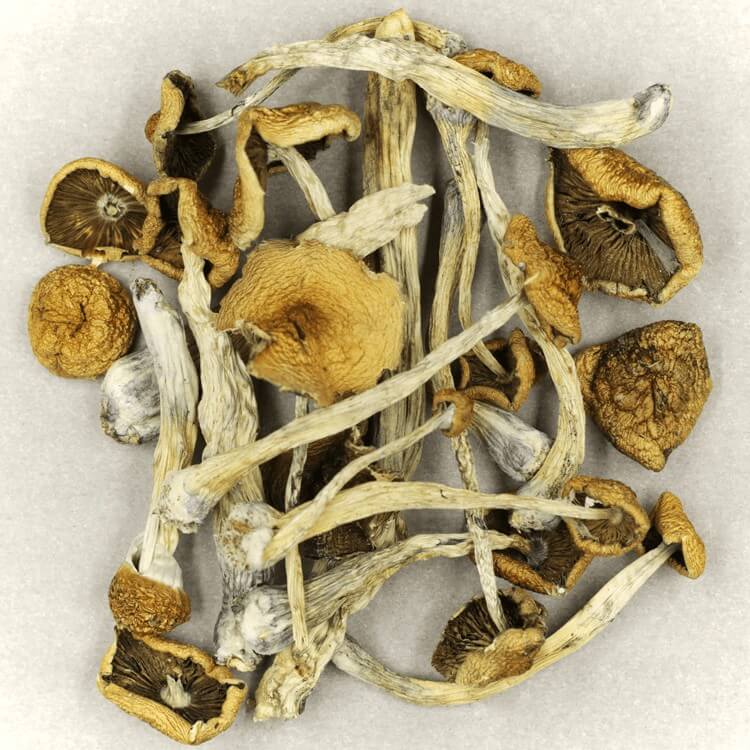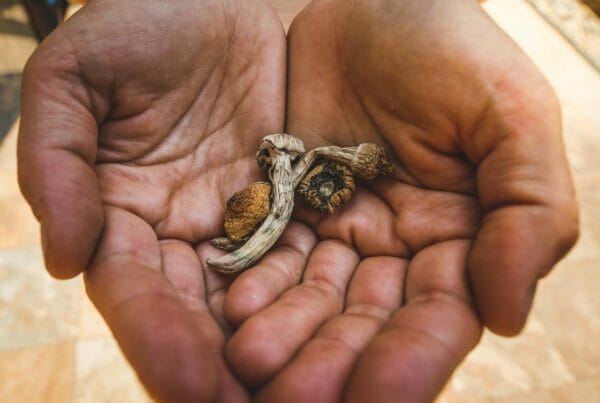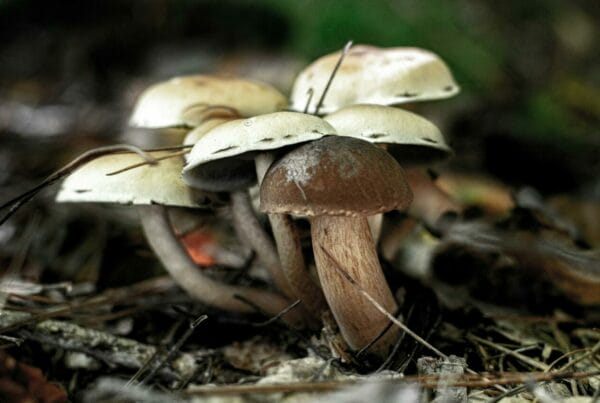Once deemed as merely whimsical, the strength of Psilocybe mexicana is now acknowledged due to ongoing psilocybin research. The psychedelic research community continuously unveils its therapeutic potential, leading to a progressive acceptance in the medical world. This burgeoning field, considered promising by experts, is actively working towards establishing safe dosage levels for medical usage.
Key Takeaways
- Researchers are using advanced techniques like liquid chromatography alongside tandem mass spectrometry to ascertain mushroom potency.
- Clinical trials are studying Psilocybe Mexicana, among other mushroom species, to evaluate its potential therapeutic applications.
- A precise dosage chart relies on the genetic diversity in magic mushrooms.
Psychedelic Mushrooms: Journey from Mystery to Research Revelations
While previously only a few conditions were thought to benefit from Psilocybe Cubensis, current research on psilocybin is revealing an array of hidden medicinal qualities.
Researchers are exploring the potential of Psilocybe Mexicana and other potent strains for wide-ranging studies and clinical trials. Regardless of whether the studies are in vivo or in vitro, this strain proves effective in demonstrating the genuine effects and benefits of the fungus species.
Psychedelics’ Market Emergence
Once shrouded in mystery, now unveiled—the continuous progression and findings are increasingly drawing public attention, especially from those seeking therapeutic solutions. Traditional mental health treatments frequently fall short, leading individuals to explore more dependable alternatives.
Enter the era of magic mushrooms.
Psilocybin is becoming a sought-after alternative for patients with mental health issues as it shows potential in treating conditions like depression, alcohol dependency, anxiety, compulsions, tics, chronic pain, and more.
Clinicians are currently devising innovative ways to accurately determine the optimal dosage for safe patient administration. Notably, researchers from the University of Texas have devised a model to extract psilocybin and psilocin concentrations.
Determining the clinical potency of magic mushrooms is indeed achievable.
Distinctive Features of Mexicana
Species such as Golden Teachers, Blue Meanies, and B-Plus have undergone extensive research. However, to enhance our knowledge of safe magic mushroom usage, it’s critical for researchers to delve into other species.
The Mexicana species has gained popularity in the research field. This isn’t merely because it’s one of the oldest species, but also due to its relatively low potency, which potentially aligns better with medical drug standards.
Although the potency of this Mexican strain is less pronounced compared to other species, it can elicit similar effects as mainstream strains. As microdosing gains traction among patients, this strain becomes a preferable option.
It boasts consistent psilocybin and psilocin levels, akin to other strains. So, what makes it stand out from similar strains? Its historical and anthropological significance is the key.
Unraveling a Rich “Mexican” Heritage
In bygone eras, psilocybe mexicana would naturally sprout in moss. Indigenous populations held these psilocybin mushrooms in high esteem for their wide-ranging applications, often linked with mystical or supernatural occurrences.
Let’s focus on Mexican mushrooms. Over 2000 years ago, the initial documented usage of these mushrooms was by the North and Central American natives. The Aztecs, an ancient civilization, dubbed these mushrooms as the “food of the Gods,” or “teonanácatl” in their vernacular.
If the Aztecs were present today, they would verify the transformative, emotionally potent, and mentally balancing effects of the Mexicana—albeit without comprehending these contemporary terms.
Despite varying cultivation methods, this mushroom has preserved its natural psilocybin levels, a testament to its authenticity. This authenticity is a universal standard that researchers and psychedelic research institutions deeply appreciate.
Innovative Approaches to Psilocybin Content and Potency Assessment
A team of ten researchers from the University of Texas at Arlington and other research institutions have designed a novel method to assess the potency of psychoactive compounds in mushrooms. This new measuring model integrates liquid chromatography and tandem mass spectrometry.
Here are two pioneering techniques:
- Liquid chromatography serves as a technique to dissect and analyze chemical mixtures, utilized here for evaluating the active chemicals in mushrooms. It operates by introducing a liquid sample to a column filled with a solid material, also known as the stationary phase. As the chemicals in the sample interact with the stationary and mobile phases in unique ways, they separate at different speeds while moving through the column.
- Spectrometry is a study that focuses on the interplay of matter with electromagnetic radiation across a spectrum of wavelengths. It recognizes and gauges substances based on the distinct wavelengths of light each molecule absorbs and scatters. This process facilitates the identification of the electronic, vibrational, and rotational states of the chemical.
This method was used to examine five strains of magic mushrooms. The findings revealed that the average total quantities of psilocybin and psilocin across these strains spanned from 0.879 to 1.36. These concentrations outdid many strains, including Bull Run and Cambodian. The research’s accuracy was verified by comparing the findings with results from other independent laboratories.
The uniformity of the results from both labs further affirmed the reliability of the test sequence in accurately determining the potency of the mushrooms.
If these results are confirmed by experts, it could lead to the addition of new techniques to the current psychedelic strength test methods, acting as an extra layer of safety to avoid incorrect dosage determinations.
Expanding Research to Include More Species
Extending the scope of research to include more species is advantageous. It can deepen our knowledge of the health benefits tied to different strains, and provide insight into the effects of less potent mushrooms.
Furthermore, it can assist in informing people about the influence of different dosages on the psychedelic experience. By contrasting Mexicans with stronger strains like Psilocybe Cubensis, researchers can determine how variations in the concentration of active compounds can impact therapeutic results.
For example, the Blue Meanies strain induces more potent hallucinogenic effects, which could be particularly beneficial in treating conditions such as depression. On the other hand, strains suitable for microdosing or subtler uses like enhancing mood or improving focus could be more suitable.
Genetic Diversity Can Lead to Safer Treatments
It’s not widely recognized that different cultivars or varieties possess distinct genetic profiles and differ in potency, chemical composition, and effects. Understanding these differences allows healthcare professionals to select the most fitting kind for specific medical applications and adjust doses to meet individual requirements, thus minimizing potential risks and maximizing benefits.
Take, for instance, Psilocybe Semilanceata (Liberty Caps) or Psilocybe cyanescens. These possess distinct alkaloid profiles that may be beneficial for treating anxiety. On the other hand, other synthetically grown mushrooms may be better suited for addressing substance addiction or compulsive behaviors. This diversity enables the development of personalized treatments with enhanced safety and efficacy.
From this, we can infer that the genetic diversity in hallucinogenic mushrooms, coupled with innovative techniques for potency assessment and identification, is vital for crafting safer medicinal treatments.
Enhancing Safety in Medical Use
Let’s pause for a moment to consider the potential benefits of safer dosage administration.
- Decreased risk of overdosing: Accurate dosing eliminates the fear of overdose. This also suggests the need for more transparent product labeling to avoid user misunderstandings.
- Better predictability: Accurate dosing allows users to foresee the effects they might experience during their sessions, which can help reduce overwhelming sensations and anxiety, thus enhancing patient satisfaction.
- Standardized measurements: Precise dosing could pave the way for a standardized metric, empowering people to refer to charts for anticipated effects.
Experience the Advantages of Accurately-dosed Shrooms through Advanced Potency Tests | Buy Magic Mushrooms Online at Where To Buy Shrooms Canada
With the continued advancement of these techniques, you’ll be able to avoid unforeseen effects. Pair this with smart online shopping at Where To Buy Shrooms Canada. We offer dried mushrooms that provide a tranquil, soothing psychedelic experience without excessive psychoactivity. Buy psychedelics online in Canada with Where To Buy Shrooms Canada.
Frequently Asked Questions
Is the Mexican Psilocybe Mexicana similar to the Big Mexican?
Are Big Mexicans and Psilocybe Cubensis identical?
No, Big Mexicans and Psilocybe Cubensis are different mushroom strains, so it’s crucial not to confuse them. Big Mexicans have a higher compound concentration, ranging from 0.5% to 1%, making them significantly more potent.
Psilocybe Cubensis, on the other hand, often contrasts in appearance. It generally has a bell-shaped cap, unlike the usually conical shape of the latter.
What is the highest concentration of psilocybin in Mexican mushrooms?
The concentrations of both psilocybin and psilocin in Mexican mushrooms can go up to 0.25%. Though these levels are relatively low, comparable to the Golden Teacher strain, they can still induce deep psychedelic experiences, which may have potential health benefits.
What is the safe dosage for medical purposes?
Generally, a dosage ranging from 1 to 2 grams is considered safe. However, this may differ based on variables like consumption methods, personal metabolism, and the particular strength of the strain. Some individuals opt to consume sub-threshold doses between 0.05 (50mg) and 0.025 grams (250mg) in order to mitigate the hallucinogenic effects.





